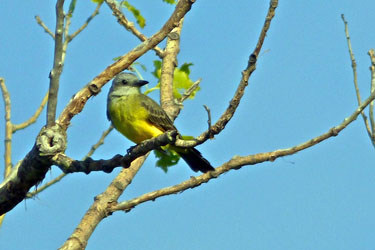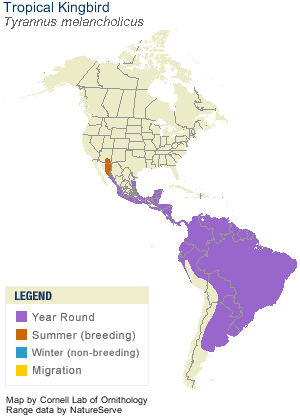
It was spotted by a keen observer down in the Murphy-Hanrehan Park, part of the Three Rivers Park district in Savage, Minnesota. The tropical kingbird is most often seen in Texas, Arizona and in Central and South America. No one really knows what it is doing so far out of its area, but nevertheless, it is here.
After going down to Murphy-Hanrehan once and failing to find the bird my wife, Carolyn, and I went down again a few days later to try again. I read several reports of its sightings, and it seemed that you had your best chance early in the morning or from 6 p.m. on, so we timed our visit to arrive in the evening.
The tropical kingbird is between 8 1/2 and 9 inches long. It has a pale gray head with a darkened mask-like area around its eyes and a gray bill. The back is gray-green and it has a forked tail. The throat is grayish and then beneath that is an olive yellow that turns into yellow on the belly and on down.
Though I had never seen one before, I had looked at photos and I familiarized myself with its call from an app on my iPod. We came equipped with a trail map of the park, but having been there before, I knew that the park spotting posts were at times hard to find. Nevertheless within half an hour we found the area where it had been reported.
Upon arrival we saw a young man with his wife and children and they were looking at a bird up in the dead part of a tall cottonwood tree. Without even introducing myself, I asked him if he had the tropical kingbird. He nodded and said, "Yes, I think so." I looked and because of the light we could only make out a silhouette, but it had the general shape and size of one, so we walked a bit farther and got a better angle on it. I then saw the tell-tale yellow belly on it and knew that we had it. Both Carolyn and I were very excited. It was a lifer for both of us, but as it turned out, it was not a lifer for the young man or his wife. They had seen it only the week before down in Texas, but they knew how rare it was here.




Reader Comments
to our Newsletter